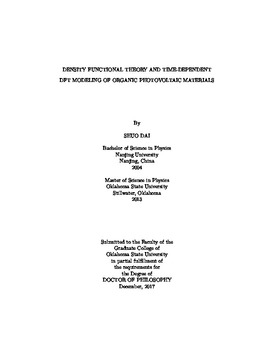| dc.contributor.advisor | Borunda, Mario F. | |
| dc.contributor.author | Dai, Shuo | |
| dc.date.accessioned | 2018-06-18T16:02:32Z | |
| dc.date.available | 2018-06-18T16:02:32Z | |
| dc.date.issued | 2017-12 | |
| dc.identifier.uri | https://hdl.handle.net/11244/300088 | |
| dc.description.abstract | This thesis has aimed to apply Density Functional Theory (DFT) and Time-dependent DFT (TD-DFT) method to design new organic material for small molecule organic photovoltaic (OPV) and molecules for tandem structure solar cells. The sources of virtual molecules are both from a focus library, consisting of bio-inspired eumelanin based molecules, and from a diverse library, which is the Harvard Clean Energy Project Database (CEPDB). | |
| dc.description.abstract | Chapter 2 validated our method. We first tried to find the density functionals that have best performance among all categories of functionals for HOMO, LUMO and gap calculations. For HOMO only, range separated functional, M06-2x, PBE0 provided the top results; for Gap prediction, PBE, TPSS and HSE06 provided the top results. Then in chapter 3, armed with the selected functionals, we carried out DFT/TD-DFT calculations to study molecules built from a bio-inspired melanin family. After studies on the structure and property relationship of the designed push-pull donors, we further suggested many virtual molecules for small molecule photovoltaic. Finally, in chapter 4, we designed a descriptor, correlation ratio, to describe the alignment between absorption spectra and solar spectrum. With DFT/TD-DFT calculations and correlation ratio, we then able to search for ideal molecules for tandem solar cells, whose spectra would be complimentary so that molecules in the tandem solar cell can achieve a full absorption of the sunlight. | |
| dc.description.abstract | The topic of discovering new material for renewable energy is essential to solve the major challenge in energy. The question is how to discover new materials from the huge chemical space efficiently. One of the approaches is associated with the progress in computational modeling, e.g. machine learning and the progress in hardware development. In chapter 2 of this dissertation, I used k-fold cross-validation to justify the validity of the model. This technique is one of the fundamental algorithms in machine learning. Additionally, there is a great progress in hardware development in recent years, which made the quantum calculation of large molecules done in chapter 3 and a large scale high-throughput screening done in chapter 4 possible. | |
| dc.format | application/pdf | |
| dc.language | en_US | |
| dc.rights | Copyright is held by the author who has granted the Oklahoma State University Library the non-exclusive right to share this material in its institutional repository. Contact Digital Library Services at lib-dls@okstate.edu or 405-744-9161 for the permission policy on the use, reproduction or distribution of this material. | |
| dc.title | Density functional theory and time-dependent DFT modeling of organic photovoltaic materials | |
| dc.contributor.committeeMember | Mintmire, John W. | |
| dc.contributor.committeeMember | Rosenberger, Albert T. | |
| dc.contributor.committeeMember | Zhou, Donghua | |
| dc.contributor.committeeMember | Nelson, Toby L. | |
| osu.filename | Dai_okstate_0664D_15577.pdf | |
| osu.accesstype | Open Access | |
| dc.type.genre | Dissertation | |
| dc.type.material | Text | |
| thesis.degree.discipline | Physics | |
| thesis.degree.grantor | Oklahoma State University | |
